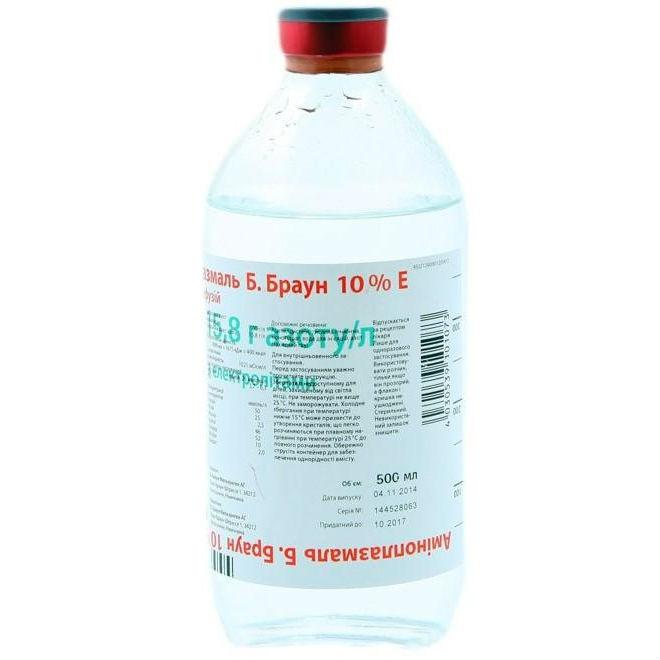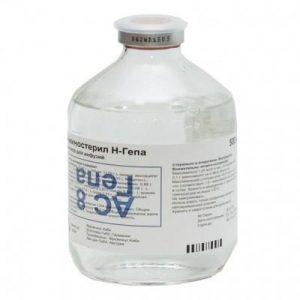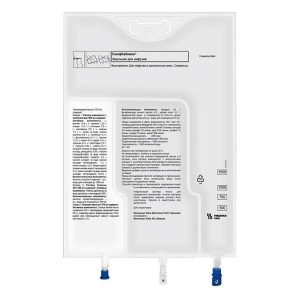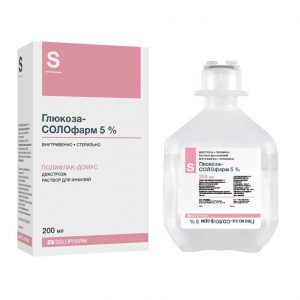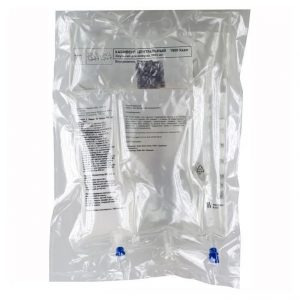Description
Release form
Solution for infusion
Packing
Bottle 500 ml.
Pharmacological action
Aminoplasmal E – supplementing the deficiency of amino acids and electrolytes.
Included in the composition of 20 amino acids (in the form of levorotatory isomers) are well absorbed and provide protein synthesis substrate. Normalizes electrolyte balance.
Calorie content of the solution is 400 kcal / l (1675 kJ / l), osmolarity – 1030 mOsm / l.
Indications
Parenteral Nutrition.
Prevention and treatment of protein deficiency due to pronounced loss and / or increased need for proteins: pre- and postoperative period (in cases when normal eating is impossible or undesirable), injuries (moderate and severe), burns, damage to the esophagus or stomach with caustic substances , stenosis of various sections of the gastrointestinal tract, diffuse peritonitis, osteomyelitis, hypoparathyroidism, malabsorption syndrome, inflammatory diseases of the gastrointestinal tract, prolonged diarrhea, vomiting, anorexia, cachexia in cancer, prolonged fever, poisoning, stroke, coma, nephrosis, amyloidosis.
Contraindications
Severe circulatory disorders with life-threatening effects (for example, shock), amino acid metabolism disorders, severe hepatic impairment, hyperhydration, renal failure with increased residual nitrogen, acidosis, hyperkalemia, hyponatremia.
Use during pregnancy and lactation
Due to the fact that the safety of Aminoplasmal during pregnancy and lactation has not been studied, the drug should not be used during pregnancy, especially in the first trimester, except in situations in which the potential benefit to the mother exceeds possible risk to the fetus.
Composition
Active ingredients:
isoleucine 5.1 g
leucine 8.9 g
lysine hydrochloride 7 g
methionine 3.8 g
phenylalanine 5.1 g
threonine 4.1 g
trip 4, 8 g
arginine 9.2 g
histidine 5.2 g
glycine 7.9 g
alanine 13.7 g
proline 8.9 g
aspartic acid 1.3 g
asparagine monohydrate 3.72 g
acetylcysteine 0, 68 g
glutamic acid 4.6 g
ornithine hydrochloride 3.2 g
serine 2.4 g
tyrosine 0.3 g
acetyl tyrosine 1.23 g
sodium acetate trihydrate 3.95 g
potassium acetate 2.45 g srdlk magnesium acetate tetrahydrate 0.56 g
sodium dihydrogen phosphate dihydrate 1.4 g
malic acid 1.01 g
Dosage and administration
Intravenous drip.
Infusion rate – up to 1 ml / kg / h.
The dose is set individually (depending on the condition of the patient), as a rule: 10% (5%) solution – up to 20 (40) ml / kg / day for the prevention and treatment of minor protein deficiency – 8 16 (16 32) ml / kg / day, to meet the body’s need for proteins during pregnancy and after surgery – 16 20 (32 40) ml / kg / day.
Side effects
Too fast administration of the drug can lead to symptoms such as chills, nausea, vomiting.
In such cases, the drug should be discontinued and resumed later at a lower rate of infusion.
Drug Interaction
It is not recommended to introduce any other drugs into Aminoplasmal 10% E solution, preferably to include them in standard carbohydrate and electrolyte solutions.
However, when it is necessary to use a mixture of preparations with Aminoplasmal 10% E, it is recommended that they be tested for compatibility before use.
Overdose
Symptoms: Growing kidney failure.
Treatment: symptomatic with mandatory reduction of the infusion rate or termination.
Storage conditions
In the dark place at a temperature of no higher than 25 ° C.
Shelf suitability
3 Year
Active ingredient
Amino acids for parenteral nutrition Prochye Preparations Myneral
dosage form
dosage form
infusion solution
